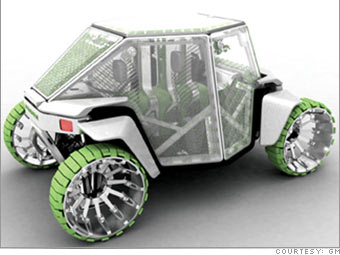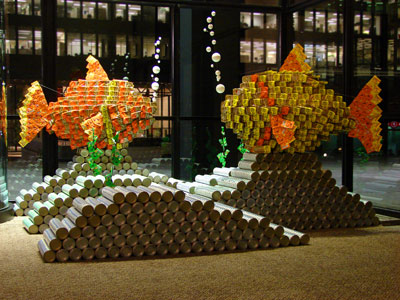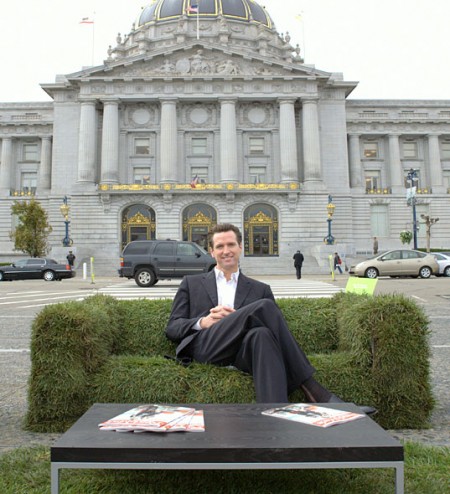
|
||
|
|
||
|
12 04
Ed Burtynsky: World Changing
 Nickel Tailings No. 31, Sudbury, Ontario 1996 Yesterday’s Toronto Star had a good story on Toronto artist Ed Burtynsky. It seems that many are worried Burtynsky’s work will become single-issue posters for environmental issues. While the Liberal’s new leader, Stephane Dion, might say that’s a good thing, it is unlikely that history will come to the same conclusion about the photographs. Burtynsky’s long history of documentation have more to do with the process and effects of massive-scale human activities than they do with the specific environmental impact of those actions. I’ve always thought that his works come from the conceptualist’s tradition which allows him to turns his vision to a host of related topics but maintain an overarching coherence to the work. In his own words:
12 03
If Hummers Can Go Green There Is Hope For The Future Of The Planet
 For Canadians who cringe whenever they see a massive, carbon-belching Hummer squeezing through the streets of our cities, this news may surprise and delight. It turns out that the designers at General Motors -- who have long seemed bent on self-destruction by producing cars few consumers wanted to buy -- have discovered that the world wants green alternatives. A generation late to be sure but suddenly they've embraced the religion of sustainability. Take a look at their recent proposal for a "green" Hummer. Called the Hummer O2, the car produces oxygen instead of CO2: This fuel-cell powered Hummer would produce oxygen. Agae-filled body panels could break down C02, a greenhouse gas, releasing oxygen into the atmosphere. When parked, body panels would fan out to catch more light, speeding the process. The 02 would be constructed from 100-percent post-consumer recycled aluminum. GM and Ford managers have long seemed incapable of responding to consumer demands for fuel-efficiency and reliability. As a result, other car producers in Japan or Germany, for example, where urban density demands a smaller, more economical type of automobile, have stepped in to fill the growing demand for more efficient cars. Jobs in the North American automotive sector are now disappearing as a result of the hubris of their 20th Century management choice to ignore consumer needs and build gas-guzzling beasts like the Hummer. Many in the green sector can take a degree of "I told you so" satisfaction. After all, it did not take too much prescience to see the future on this issue. We have to wonder why companies engage in these self-destructive choices. Is it a matter of short-term thinking? If so, our manufacturing class must learn from the disruptive forces that are changing their sectors and refocus on the future. If they don't, we will risk handing over our economic prosperity to those countries who will.
11 29
Lets Green This City
The project is co-sponsored by the Pacific Gas and Electric Company and ReadyMade Magazine. http://www.letsgreenthiscity.com is one component of a campaign dedicated to making San Francisco the “greenest” city in the United States. Given the city of Toronto’s obsession with bad street amenities, maybe trying to make the city “green” would result in 21st. century design solutions.
11 28
Wal-Mart + Green = Disaster?
Mother Jones has a story by writer Bill McGibbon on the green initiatives of major corporations. McGibbon reflects on the paradox created when short-term profit driven corporations embrace what by nature have to be long-term thinking green initiatives. The results can be jarring:
McGibbon’s take is similar to that of the documentary, “The Corporation.” In that film, corporations are portrayed as innately profit-driven entities without a social conscience - sociopaths. As a result, they make choices that are not in the best interest of society. While this argument contains some truth - maybe a lot of truth - it is ultimately superficial. Why? Like good and bad people, good and bad corporations exist in an overarching political and social environment. If we offer effective regulatory infrastructures like, for instance, ISO sustainability standards, good corporations see the benefits of adopting them and the overall market changes. However, if our government does not make strong compliance regulations, the public cannot fault corporations who, to be competitive, produce goods within the constraints of that regulatory environment. We, as the ultimate recipients of the good and bad results of those decisions, have only ourselves to blame. So, it may be comforting for us to blame corporations for our environmental problems. They do deserve criticism. However, we must not forget that as citizens we have the choice of getting involved and changing public policy and, as consumers, of not buying from companies who are intentionally and without regret helping to destroy the place we inhabit.
11 27
Drastic Ideas For Sustainability
 Last week the Associated Press reported that scientists at the United Nations conference on climate change offered some "out of the box" ideas on how to reduce global warming. Dr. Paul Grutzen, of Germany's Max Planck Institute, said that unless the world's polluting nations take immediate and strong action to curb emissions we will have to resort to "startling" solutions to the problem. Today, according to Grutzen, the world's policy makers exhibit a "grossly disappointing international political response to warming." What are Grutzen's startling solutions? Well, they are drastic. One involves hoisting heavy guns to high-altitutes where they would blast the stratosphere with sulphates. This action would have an effect much like that created by the eruption of Mount Pinatubo in 1991. When that volcano erupted it cooled the earth by nine-tenths of a degree for one year. The need for drastic ideas like this one are closer than you think. They may be one generation away.
Fish Food At The TD Centre
 As I hurried to the Design Exchange last Thursday for the annual design awards, I passed through the lobby of the Mies van der Rohe designed TD Centre. Along the north wall were sculptures made from thousands of cans - food cans destined for Toronto’s Daily Bread food bank. I did not have enough time to stop for details although I think an engineering society created this installation. Does anyone have the story behind the can-based sculptures? They are worth looking at and remember, donations to the food bank are an effective way to contribute to the health of our community. Update: Here is a link to more information on the event. Last year’s winners were Diamond and Schmidt Architects. The sculptures will be on display at the TD Centre until December 1.
11 24
Child Labourers Experience Systemic Violence
 Think back to being eight years old. No, really. Think back. Think back to being eight years old. No, really. Think back. Close your eyes, shut your ears and travel into a memory: you and your best friend toboggoning down a snow-covered hill; you, seated in your desk at school, sharpening your HB to a point so you could poke the kid beside you; the smell of rain on hot concrete; what it feels like to nail a cannonball; the taste of cookie batter, licked straight off a wooden spoon; tears, excitement, sheer joy, fear. What would we be like without those memories? Modern childhood in the developed world is a time of carefree discovery for most. Children feel safe and loved, so they're free to explore the world around them with an innocence and wonder that can never be recaptured. My memories give me a safe place to retreat to when I'm sad, scared, frustrated or hurt. I can recapture that feeling of safety, and it grounds me. This past Monday, the United Nations International Labour Organization published a report that outlined the systemic violence committed against child labourers. Many of the world's 218 million child labourers are physically, verbally and emotionally abused every day. Children who work to help feed their family, because they have no family, or are forced to as part of their family's debt bondage are not innocent, but helpless. What will happen to them when they grow up? Where will they go to escape? Without those memories of innocence, discovery and excitement, what will they think of this world? A child without a childhood has nothing to strive for, because they don't know how good life can be. What is there for them to hope for and work towards? Developing countries need their children to grow up into healthy, productive, passionate people--they represent hope for the future. Child labour doesn't only jeopardize the lives of the milllions of children involved, but the lives of whole communities, and the future of countries. |

Contribute to the MESH Cities intelligent city database. Click here.
Read what people are saying about the environmental issues that impact us all
News about wind energy
News about green investing
Blog posts about electric cars
|
The best green news sources on the Net
Treehugger
Eco Worrier
Inhabitat
Lime
World Changing
|
